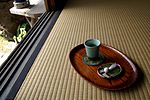Sen no Sōtan (千宗旦) (1578–1658), also known as Genpaku Sōtan 元伯宗旦, was the grandson of the famed figure in Japanese cultural history, Sen no Rikyū. He is...
4 KB (669 words) - 04:16, 18 March 2022
mentioned by Rikyū's grandson Sen no Sōtan. In a 1663 list given by Sōtan's son (and fourth-generation head of the Sen Sōsa lineage of tea masters), Maeda...
17 KB (2,266 words) - 08:01, 8 June 2024
already had a son born of himself and Okame, Sen Sōtan, to succeed him as head of the Kyō-Senke. Sōtan had five offspring: the elder two, Kan'ō Sōsetsu...
27 KB (2,881 words) - 03:30, 20 July 2023
Shōan's son Sen Sōtan soon succeeded as the family heir and head of this estate. The next heir to the estate and family tradition was Sōtan's third son...
7 KB (609 words) - 21:06, 20 October 2023
Okame was Sen Sōtan, the third generation in the Sen family tradition of Japanese tea ceremony. Shōan was the same age as Rikyū's oldest son, Sen Dōan, but...
3 KB (432 words) - 10:44, 25 February 2022
style of tea ceremony considered to have been perfected by Sen no Rikyū and furthered by Sen Sōtan is known as wabi-cha. The san-Senke have historically championed...
15 KB (1,972 words) - 02:11, 10 December 2023
(Daiyū 大有), Sen Dōan (Min'ō 眠翁), Sen Sōtan, (Genshuku 元叔) and Yabunouchi Jōchi (Kenchū 剣中). Sōen was also closely associated with Imai Sōkyū and Sen Rikyū....
7 KB (867 words) - 20:33, 12 April 2024
designated a National Treasure in 1951. Konnichi-an (今日庵, Today Hut) built by Sen Sōtan at what later became known as the Urasenke Konnichian estate. The floor...
20 KB (2,439 words) - 20:39, 2 June 2024
use the hereditary name was Sen no Rikyū's great-grandson, known as Kōshin Sōsa (1613–1672), the third son of Sen no Sōtan, who inherited the main house...
1 KB (162 words) - 12:55, 22 March 2022
this line of the Sen family to use the name Sōshitsu was the youngest son of Sen no Sōtan; in other words, a great-grandson of Sen no Rikyū. He is generally...
1 KB (195 words) - 04:08, 20 October 2022
Japanese rock garden. 45. Japan Urasenke Tea Garden, Kyoto Tea room built by Sen Sōtan. Website 46. Japan Tofuku-ji Temple Garden, Kyoto Designed by Mirei Shigemori...
23 KB (205 words) - 22:37, 21 May 2024
month (1691). He was responsible for bringing Yamada Sōhen, a disciple of Sen Sōtan, to Edo to promulgate the practice of the Japanese tea ceremony. Ogasawara...
3 KB (230 words) - 23:22, 15 March 2023
History of tea in Japan (section Sen no Rikyū)
Omotesenke, Urasenke, and Mushakōjisenke, were all founded by children of Sen no Sōtan, Rikyū's grandson. Developments in the Japanese tea ceremony during the...
23 KB (3,062 words) - 07:45, 16 August 2024
century. Sen no Rikyū's descendants, in turn, preserved a simpler style, following in their forefather's footsteps. His grandson Sen no Sōtan attracted...
104 KB (13,127 words) - 09:28, 8 August 2024
of the Sen family, counts its founder as Sen no Rikyū. Sensō Sōshitsu was the youngest son of Sen no Sōtan; and he was a great-grandson of Sen no Rikyū...
4 KB (509 words) - 13:12, 30 April 2024
most of Kyūshū. Hideyoshi had the support of the wealthy merchant, Kamiya Sōtan, and other prominent merchants in the port city of Hakata, and after his...
11 KB (1,722 words) - 05:58, 18 March 2023
Mushakōjisenke is associated with Sen no Rikyū's great-grandson Ichiō Sōshu (一翁宗守), who was the second to the oldest of Sen no Sōtan's four sons. Like his older...
3 KB (260 words) - 07:51, 30 October 2023
Fujitaka Shōgo Shimada as Sen no Rikyū Kichijirō Ueda as Saitō Dōsan Ichirō Mikuni as Imagawa Yoshimoto Yoshio Tsuchiya as Sōtan Frankie Sakai as Ofuku Harue...
7 KB (527 words) - 10:46, 11 December 2023
1928. Yūin chaseki (又隠茶席) is a copy of the one built by Sen no Rikyū's grandson, Sen no Sōtan (1578-1658). It was built during the An'ei years (1772-1780)...
81 KB (10,596 words) - 10:50, 19 August 2024
the founder of the Kazehaya family, learned Japanese tea ceremony from Sen no Sōtan. Ever since, the heads of the Kazehaya family served in the Imperial...
4 KB (349 words) - 17:41, 21 May 2024
Jesuit missionaries document the room's appearance, such as those by Kamiya Sōtan, Yoshida Kanemi, and Ōtomo Sōrin. The room was made from Japanese cypress...
16 KB (1,700 words) - 10:19, 31 August 2024
born 1595) Carlo Ridolfi, Venetian painter and biographer (born 1594) Sen no Sōtan, Japanese poet (born 1578) Pedro de Torres Rámila, Spanish poet, satirist...
28 KB (3,020 words) - 18:28, 18 June 2024
it gradually changed the direction of Sōtō Zen monastic education ... Sōtan's lectures provided a model that could be emulated by each of the other Zen...
51 KB (5,923 words) - 07:30, 1 June 2024












